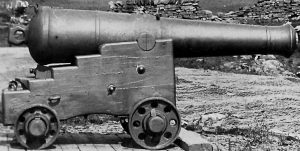1860-1890: 32-Pounders

Smooth bore 32-pounders were old naval cannon. When fired from warships at close range (300 metres), a 32-pound cannonball could penetrate a wooden hull over two feet thick.
The Volunteer Artillery used them for coastal defence over much longer ranges – typically 1300 metres. Each company was entitled to two guns, but it took sixteen years before Easdale’s two companies got four guns that worked.
85254, received 1860, made 1826, 2.4 tonnes, 8 feet long.
85283, received 1860, made 1826, 2.4 tonnes, 8 feet long
85264, received 1860, made 1826, unserviceable.
262, received 1873, made 1839, 2.0 tonnes, 7 feet 6 inches long.
1184, received 1876, made 1845, 2.1 tonnes, 8 feet long, replaced 85264.
1891-1908: 64-Pounders

The new 64-pounder guns were 32-pounders which had been converted to a rifled barrel. The inside had twisting grooves which made a projectile spin. They were heavier at 2.9 tonnes and longer at 10 feet 7 inches. These guns could fire a 64-pound spinning shell much farther than a cannonball.
The Volunteers practised over typical ranges of 2000 metres, but the guns were powerful enough to reach twice that distance.
317, received 1874 but not used until 1891.
296, received 1891.
531, received 1891.
536, in use by 1897.
Ammunition included ‘common shell’ with percussion fuzes which exploded on impact; and shrapnel shell with time fuzes, which detonated above the target.
The time fuze was made of beechwood. Its core contained a powder which burned at a fixed rate: one inch every seven and a half seconds. On the outside were rows of numbered holes, and at the tip of the fuze was a quick-match – like the touch-paper of an old firework. The commander of each gun would take a pointed tool and bore through one of the holes at the setting ordered. When the gun was fired, flame from the cartridge ignited the quick-match which instantly lit the slow-burning powder. When this had burned through to the bored hole, it ignited gunpowder which exploded the shell.
Top photo – diagram of a 64-pounder gun barrel
